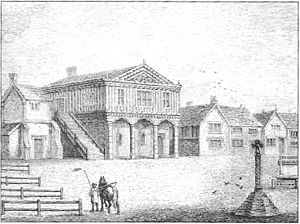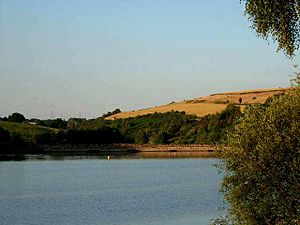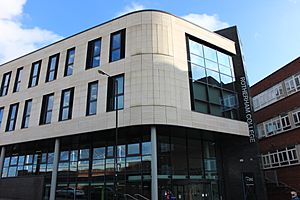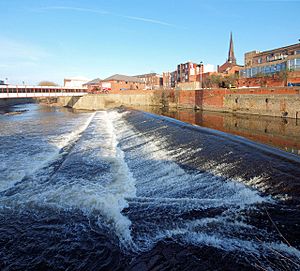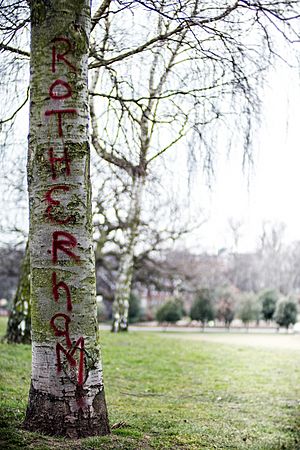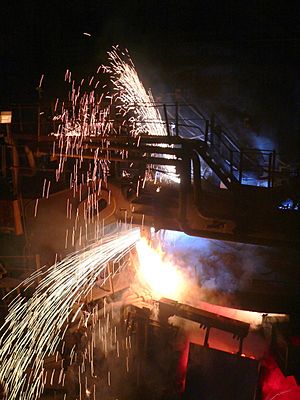Rotherham facts for kids
Quick facts for kids Rotherham |
|
|---|---|
| Town | |
|
Top to bottom, left to right: Rotherham Effingham Square, Bridge and Chapel, Town Hall, River Don Weir, Beeversleigh Flats and Minster |
|
| Population | 109,691 (2011 census) |
| OS grid reference | SK4392 |
| Metropolitan borough |
|
| Metropolitan county | |
| Region | |
| Country | England |
| Sovereign state | United Kingdom |
| Post town | ROTHERHAM |
| Postcode district | S60-S62, S65, S66 |
| Dialling code | 01709 (01226 in areas) (01909 in areas) (0114 in areas) |
| Police | South Yorkshire |
| Fire | South Yorkshire |
| Ambulance | Yorkshire |
| EU Parliament | Yorkshire and the Humber |
| UK Parliament |
|
Rotherham (![]() i/ˈrɒðərəm/ rodh-ƏR-əm) is a market town in South Yorkshire, England. It lies at the confluence of the River Rother, from which the town gets its name, and the River Don. It is the largest settlement of the Metropolitan Borough of Rotherham.
i/ˈrɒðərəm/ rodh-ƏR-əm) is a market town in South Yorkshire, England. It lies at the confluence of the River Rother, from which the town gets its name, and the River Don. It is the largest settlement of the Metropolitan Borough of Rotherham.
Before the Industrial Revolution, traditional industries included farming, glass making and flour milling. In the late 18th and 19th centuries, Rotherham became known for its coal mining and, later, steel industries. The town's historic county is Yorkshire, and Rotherham was once part of the West Riding of Yorkshire. In 1974, this administrative county was abolished during a reorganisation of local government. Subsequently, Rotherham became part of the county of South Yorkshire, where it makes up one of four metropolitan boroughs.
Rotherham had a population of 109,691 in the 2011 census. The borough had a 2020 population of 265,411, the 60th most populous district in England.
Contents
History
Early history
Iron Age and Roman settlements dot the area covered by the district, including a small Roman fort to the south-west in the upper flood meadow of the Don. Rotherham was founded in the very early Middle Ages. Its name is from Old English hām 'homestead, estate', meaning 'homestead on the Rother'. The river name was carried into Old English from Brittonic branch of Celtic words: ro- 'over, chief' and duβr 'water', thus 'main river'; a similar size namesake is in East Sussex, see Rother. It established itself as a Saxon market town, on a Roman road near a forded part of the River Don.
By the late Saxon period, Rotherham was at the centre of a large parish on the Don's banks.
Following the Norman Conquest an absentee lord held the most inhabited manor, Nigel Fossard (however today's city proper takes in eight outyling Domesday estates). The Domesday 'Book' or Survey records this lord of the manor with a Norman name took the place of the Saxon lord Hakon holding 20 years before in 1066 and was tenant of an overlord of hundreds of such manors, Robert de Mortain, the Conqueror's half-brother. The central assets at the time were medium in rank among manors: eight adult male householders were counted as villagers, three were smallholders and one the priest, three ploughlands were tilled by one lord's plough team and two and a half men's plough teams were active. The manor's other resources were a church, four loosely called 'acres' of meadow, and seven of woodland. Rotherham had a mill valued at an ordinary half of one pound sterling.
His successors, the De Vesci family, rarely visited the town and did not build a castle but maintained a Friday market and a fair. In the mid 13th century, John de Vesci and Ralph de Tili gave all their possessions in Rotherham to Rufford Abbey, a period of growing wealth in the church. The monks collected tithes from the town and gained rights to an extra market day on Monday and to extend the annual fair from two to three days.
The townsmen of Rotherham formed the "Greaves of Our Lady's Light", an organisation which worked with the town's three guilds. It was suppressed in 1547 but revived in 1584 as the feoffees of the common lands of Rotherham, and remains in existence.
In the 1480s the Rotherham-born Archbishop of York, Thomas Rotherham, instigated the building of a College of Jesus or Jesus College, Rotherham to rival the colleges of Cambridge and Oxford. It was the first brick building in what is now South Yorkshire and taught theology, religious chant and hymns, grammar and writing.
The College and new parish church of All Saints made Rotherham an enviable and modern town at the turn of the 16th century. The college was dissolved in 1547 in the reign of Edward VI, its assets stripped for the crown to grant to its supporters. Very little remains of the original building in College Street. Walls of part of the College of Jesus are encased within number 23 and Nos 2, 2A, 4 (later for a time Old College Inn, a beerhouse), 6 and 8 Effingham Street. Its fragments of walls are the earliest surviving brick structure in South Yorkshire and are remains of the key institution to Rotherham's growth into a town of regional significance. Sixty years after the College's dissolution Rotherham was described by a wealthy visitor as falling from a fashionable college town to having admitted gambling and vice. The history of Thomas Rotherham and education in the town are remembered in the name of Thomas Rotherham College.

Industrial Revolution
The region had been exploited for iron since Roman times, but it was coal that first brought the Industrial Revolution to Rotherham. Exploitation of the coal seams was the driving force behind the improvements to navigation on the River Don, which eventually formed the Sheffield and South Yorkshire Navigation system of navigable inland waterways.
In the early Industrial Revolution major uses of iron demanded good local ore and established processing skills for iron strength, qualities found in Rotherham's smelting plants and foundries. Iron, and later steel, became the principal industry in Rotherham, surviving into the 20th century. The Walker family built an iron and steel empire in the 18th century, their foundries producing high quality cannon, including some for the ship of the line HMS Victory, and cast iron bridges, one of which was commissioned by Thomas Paine.
Rotherham's cast iron industry expanded rapidly in the early 19th century, the Effingham Ironworks, later Yates, Haywood & Co, opened in 1820. Other major iron founders included William Corbitt and Co; George Wright and Co of Burton Weir; Owen and Co of Wheathill Foundry; Morgan Macauley and Waide of the Baths Foundry; the Masbro’ Stove Grate Co belonging to Messrs. Perrot, W. H. Micklethwait and John and Richard Corker of the Ferham Works.
The Parkgate Ironworks was established in 1823 by Sanderson and Watson, and changed ownership several times. In 1854, Samuel Beal & Co produced wrought iron plates for Isambard Kingdom Brunel's famous steamship the SS Great Eastern. In 1864, the ironworks was taken over by the Parkgate Iron Co. Ltd, becoming the Park Gate Iron and Steel Company in 1888. The company was purchased by Tube Investments Ltd in 1956 and closed in 1974. Steel, Peech and Tozer's massive Templeborough steelworks (now the Magna Science Adventure Centre) was, at its peak, over a mile (1.6 km) long, employing 10,000 workers, and housing six electric arc furnaces producing 1.8 million tonnes of steel a year. The operation closed down in 1993.
Joseph Foljambe established a factory to produce his Rotherham plough, the first commercially successful iron plough.
A glass works was set up in Rotherham in 1751, and became Beatson Clark & Co, one of the town's largest manufacturers, exporting glass medicine bottles worldwide. Beatson Clark & Co was a family business until 1961, when it became a public company. The glass works operated on the same site, although the family connection ceased and the company is owned by Newship Ltd, a holding company linked to the industrialist John Watson Newman. It continues to the manufacture glass containers for the pharmaceutical, food and drinks industries. In the 19th century, other successful industries included pottery, brass making and the manufacture of cast iron fireplaces. Precision manufacturing companies in the town include AESSEAL, Newburgh Engineering, Precision Magnetics, Orkot Composites and Darron Oil Tools SBO. Rotherham is the location of the Advanced Manufacturing Park (AMP).
Milling grain into flour was a traditional industry in Rotherham, formerly in the Millmoor area, hence Rotherham United F.C.'s nickname "The Millers". Flour milling continued at the Rank Hovis town mill site on Canklow Road until September 2008. The site of the mill is a warehousing and distribution facility for Premier Foods.
Floods of 2007
Rotherham was affected by flooding in the summer of 2007, which caused the closure of central roads, schools, transport services and damaged residential and commercial property, including the Parkgate Shopping complex and the Meadowhall Centre, which suffered considerable internal water damage. Ulley Reservoir caused major concern and forced the evacuation of thousands of homes when its dam showed signs of structural damage, threatening to break and release water into the suburbs of Treeton, Brinsworth and Canklow as well as potentially flooding the Junction 33 electrical sub-station. Rother FM evacuated its studios, passing its frequency temporarily to neighbouring station Trax FM. A stretch of the M1 motorway was closed for three days owing to the flood risk in the event of a breach of the reservoir. Fire service and police officers used thirteen high-powered pumps to lower the water level in the reservoir and reduce pressure on the dam wall, which was damaged but held. By summer 2008, the reservoir and surrounding country park reopened.
A new wetland and flood storage area, Centenary Washlands, has since been built by Rotherham Council and the Environment Agency to prevent flooding in the future. Sheffield Wildlife Trust manages the site as a local nature reserve.
Landmarks

All Saints Minster, on a square of the same name, was built using neat-cut pieces made of a unique sandstone, Rotherham Red, with a low-pitched lead roofing. It is a Grade I listed building. A Belfry was added to the church in 1501 and today the Minster houses 13 bells. A church has stood on the site since before the Norman Conquest and the current building dates from the 15th century and includes parts from earlier Saxon and Norman structures. Clayton and Bell working to George Gilbert Scott's designs constructed the east window. Stained glass makers and designers A. Gibbs, Camm Brothers, Heaton, Butler and Bayne and James Bell are known makers of the other windows. Gargoyles flank its clock on each face. It has a "recessed octagonal spire with crocketed arrises and pinnacled shafts rising from corner faces and a gilded weathervane." Architectural critics Nikolaus Pevsner and Simon Jenkins considered it "the best perpendicular [style] church in the country" and "the best work in the county", respectively.
Close to the town centre is the 15th-century Chapel of Our Lady of Rotherham Bridge (or "Chapel on the Bridge"), beside Chantry Bridge (a road bridge opened in the 1930s). It is one of four surviving bridge chapels in the country. The chapel was restored in 1923, having been used as the town jail and a tobacconist's shop.
The town was once home to Jesus College, founded by Thomas Rotherham in the fifteenth century. The remains of the college's buildings are in the town centre, where some of the earliest examples of a brick-built structure remain although not accessible to the public. The gate to the College of Jesus can be found in nearby Boston Park.
Boston Castle, in the grounds of Boston Park, was built as a hunting lodge by Thomas Howard, 3rd Earl of Effingham between 1773 and 1774 to mark his opposition to British attempts to crush the Americans in their war for independence. It is named after Boston, Massachusetts, the scene of the Boston Tea Party.
Built in the 18th century, Clifton House houses Clifton Park Museum.
On the outskirts of Rotherham, a brick-built glass making furnace, the Catcliffe Glass Cone, is the oldest surviving structure of its type in Western Europe and one of four remaining in the United Kingdom – the others being the Red House Cone in the Wordsley centre of the Dudley Glassworks in the West Midlands, Lemington Glass Works west of Newcastle upon Tyne and Alloa in Scotland. Threatened with demolition in the 1960s, it has been preserved as a Scheduled Ancient Monument and stands as a focal point in a sheltered housing complex and close to the path leading up the Rother valley.
The ruins of Roche Abbey, south of Maltby and half-way to Worksop, have multi-storey walls, which is unusual. Most others abbey ruins of this age are no more than foundations or a single storey, following the dissolution of the monasteries in the 1530s.
Education
Rotherham has three Further Education institutions and colleges. These are Thomas Rotherham College, Dearne Valley College and the Rotherham College of Arts and Technology. The Rotherham College of Arts and Technology has a campus in the Rotherham town centre and a second site in Dinnington, as well as a nearby, smaller campus for construction-based subjects, such as bricklaying.
Governance
There is one main tier of local government covering Rotherham, at metropolitan borough level: Rotherham Metropolitan Borough Council. The borough council is also a member of the South Yorkshire Mayoral Combined Authority, led by the directly elected Mayor of South Yorkshire. Some outer parts of Rotherham are included in civil parishes, which form an additional tier of local government in these areas, but the central part of the built-up area is an unparished area.
Administrative history
Rotherham was an ancient parish. The parish was divided into eight townships, being Brinsworth, Catcliffe, Dalton, Greasbrough, Kimberworth, Orgreave, Tinsley, and a Rotherham township covering the central part of the parish including the town. Such townships were also made civil parishes in 1866.
Until 1801 the parish was governed by its vestry and manorial courts, in the same way as most rural areas. More urban forms of local government began in 1801 when a body of improvement commissioners was established for the Rotherham township, with responsibilities for paving, lighting, and repairing the streets. The commissioners were superseded in 1852 by an elected local board, whose district covered both the Rotherham and Kimberworth townships and had more extensive responsibilities, particularly relating to water supply and sewers.
The local board was in turn replaced in 1871 when Rotherham was incorporated as a municipal borough. In 1902 it was elevated to become a county borough, taking over county-level functions from West Riding County Council.
The county borough was abolished in 1974 and replaced by the larger Metropolitan Borough of Rotherham, which also took in the areas of the abolished urban districts of Maltby, Rawmarsh, Swinton, and Wath upon Dearne, plus the Kiveton Park Rural District and Rotherham Rural District.
The Labour Party, have controlled the authority since the 1974 incorporation of the Metropolitan Borough. Following the 2016 CSE Scandal, the way in which local councillors are elected in Rotherham changed, replacing rolling elections, held annually with whole council elections. This change also coincided with notable boundary changes, which has marked a notable change in the political landscape of the borough. Rotherham's shadow cabinet local opposition is currently the Conservative Party with 18 the seats. Independents account for one seat.
Although Labour retained control of the council, the Conservatives went from zero to 20 seats at the May 2021 election. Having had elections by thirds every other year. The method of election is changing to whole council elections every four years, from 2016.
..... Following the report's publication, the council leader, Roger Stone of the Labour Party, resigned – an act of contrition the report said should have been made years earlier – saying he would take full responsibility for "the historic failings described so clearly in the report." Labour Councillors Gwendoline Russell, Shaukat Ali and former council leader Roger Stone were suspended from the Labour Party, as was former Deputy Council Leader Jahangir Akhtar, who had lost his council seat in 2014. Chief Executive, Martin Kimber, said no council officers would face disciplinary action. Kimber announced on 8 September that he intended to step down in December 2014, and offered his "sincere apology to those who were let down". The council's director of children's services, Joyce Thacker, also left the authority by mutual agreement. Malcolm Newsam was appointed as Children's Social Care Commissioner in October 2014, and subsequently Ian Thomas was appointed as interim director of children's services.
Shaun Wright, the Police and Crime Commissioner (PCC) for South Yorkshire from 2012, was the Labour councillor in charge of child safety at the council for five years from 2005 to 2010. He initially refused demands to resign as PCC from the Home Secretary, Theresa May, as well as members of his own party and local Labour MP Sarah Champion, saying: "I believe I am the most appropriate person to hold this office at this current time." He resigned from the Labour Party on 27 August 2014, after an ultimatum by the party to either resign or face suspension from the party. Wright stood down as PCC on 16 September, saying that the prominence given to his role distracted from "the important issue, which should be everybody's focus – the 1,400 victims outlined in the report – and in providing support to victims and bringing to justice the criminals responsible for the atrocious crimes committed against them."
The former Chief Constable, Meredydd Hughes, who served from 2004 to 2011 and who had unsuccessfully stood for the Labour Party nomination in the Police Crime Commissioner elections, was told by Labour MP Keith Vaz that he had 'failed' abuse victims.
The inspector, Louise Casey aided by seven assistant inspectors produced the Inspection Report on 4 February 2015. Following its conclusion that the council was not fit for purpose the minister directed that the powers of the council (RMBC) be transferred to his department and the cabinet would need to resign unless RMBC made sufficient representations within 14 days to contradict the report. The Secretary of State empowered a team of five Commissioners to replace councillors before a full election in 2016 and on the Report's strength, stated that as the authority was not currently fit for purpose its powers would not revert until the dis-empowered councillors could prove their fitness to carry out all of the council's duties without intervention. One of these commissioners was appointed to specialise in child protection.
Constituencies
The Metropolitan Borough of Rotherham covers the constituencies of Rotherham (UK Parliament constituency) which has been held by the Labour Party since 1933; Wentworth and Dearne (UK Parliament constituency), held since labour from the creation of the seat in 1983; and Rother Valley (UK Parliament constituency), held by the Conservatives since the 2019 General Election, this marked the first time the Rother Valley Constituency changed colour since its inception in 1918 and first time the borough of Rotherham that anything other than a Labour MP was returned to Parliament since 1931.
Like most of South Yorkshire, the Rotherham constituencies are considered to be 'safe', that is having enjoyed 'substantial' majorities over a 'long' period of time; a typecast which heightens the incumbency factor present in first past the post elections. The constituency of Rotherham, which includes all its near suburbs, has been held by Labour MPs since a by-election in 1933. After the resignation and subsequent jailing of Denis MacShane in November 2012 due to expenses abuse. The by-election in 2012 saw Sarah Champion elected.
Geography
The town in great part occupies the slopes of two hills; that in the west is the start of a 3 miles (4.8 km) north-west crest topped by Keppels Column, that in the east is a narrower crest alongside the Rother known as Canklow Hill, topped by a protected formally laid out public area, Boston Park, less than 500 east of and 80 metres above the Rother. The Rother here is between 32 and 34 metres above sea level. The south scarp here is slightly higher still, the Canklow Hill Earthworks, a Scheduled Ancient Monument, one of relatively few in the borough, as pre-dating recorded history. This compares to 524 listed buildings and structures by English Heritage in the district. Samuel Lewis describing the town with its townships as having nearly 14,000 people in 1848, described the southern green slope by saying the town lies "partly on the acclivities of an eminence...great improvements have been made within the last twenty years; in the immediate neighbourhood, several substantial and respectable dwellings have been recently built".
Rotherham's commercial town centre occupies the valley in between these hills on the navigable part of the River Don flowing from the south-west after it has turned approximately due north. The town centre is less than 0.5 miles (0.80 km) below and north of the confluence of the Rother flowing from the south. The Mid Don Valley continues adjoining towns in the north of the Metropolitan Borough.
Beyond the town centre and away from the Don Valley, the Rotherham district is largely rural, containing a mixture of retired people, larger properties, some farming and tourism and the landscaped Wentworth Woodhouse estate, where the last surviving kiln of the Rockingham Pottery can be seen.
Aside from two regular roads and two bypasses (one being the motorway network), Sheffield is connected directly by the Trans-Pennine Trail which passes the Meadowhall Shopping Centre on both sides (which between the two places) as it includes Sheffield as southern detour.
Rotherham Central railway station has frequent trains connecting to Sheffield in a time of 14 minutes; Manchester through a change in Sheffield is accessible in a similar circa 70 minutes to nearer Leeds and York as many towns and suburbs in South Yorkshire and West Yorkshire are all stops on Rotherham's railway – it is Doncaster which has the East Coast Main Line providing express intercity services.
- Districts and suburbs of Rotherham include
- Kimberworth
- Town Centre
- East Dene
- Masbrough
- Bradgate
- Deepdale
- Clifton
- Herringthorpe
- Brinsworth
- Catcliffe
- Waverley
- Dalton
- Dalton Magna
- Listerdale
- Wingfield
- Keppel
- Greasbrough
- Eastwood
- Wickersley
- Bramley
- Whiston
- Parkgate
- Aldwarke
- Rawmarsh
Demography
In 2011, the urban population of Rotherham was 109,691. In 2014, it was about 110,550.
| Rotherham compared 2011 | Rotherham USD | Rotherham (Borough) |
|---|---|---|
| White British | 85.6% | 91.9% |
| Asian | 8.3% | 4.1% |
| Black | 1.3% | 0.8% |
In 2011, 14.4% of Rotherham's population were non-white compared with 8.1% for the surrounding borough. Rotherham town has over double the percentage of Asian people compared with the Metropolitan Borough of Rotherham and a slightly larger percentage of black people. Rotherham has a large Pakistani population.
As of 2021, the town of Rotherham's population was 129,897, and its ethnic makeup was 86.1% White, 9% Asian, 1.7% Mixed, 1.5% Black, 1.2% Other and 0.5% Arab. The town's religious makeup was 49.2% Christian, 40.1% No Religion, 9.6% Muslim, and has small Hindu and Sikh communities.
Culture and attractions
Museums
The Magna Science Adventure Centre is an interactive science and adventure centre built in a former steel works in Templeborough. It has become one of the most popular tourist destinations in the region.
Clifton Park Museum is a medium-sized museum in Clifton Park, with free entry.
Entertainment
The Civic Theatre and an Arts Centre is in the town centre.
The Westgate district of the town centre is the focal point of Rotherham's nightlife.
In 2015, the historic Three Crane Inn reopened on High Street in the town centre as an antiques shop. It closed in 2019, but reopened that year as a micropub. The Three Cranes Inn is Rotherham's oldest secular building and dates back to 1470.
In 2019, work began on the former Tesco site on forge island to build a multiplex cinema, 4 restaurants, new urban public space and a hotel. The project, first mooted in the early 2000s experienced many delays and finally opened in 2024, more than 20 years after the scheme was proposed.
Events
Rotherham holds several public events through the year. The fashion show Rotherham Rocks, in July, takes place in 'All Saints Square'. Rotherham by the Sea, in August, is held in Clifton Park, which is transformed into a seaside beach with sand, deckchairs and other traditional seaside attractions. The Rotherham Show is an annual event, held in Clifton Park, with stalls from all sectors of the community, shows and live bands in September. The Rotherham Real Ale and Music Festival hosted at the Magna Centre, is one of the UK's largest Real Ale festivals, and typically runs over 4 days.
In 2016 Rotherham's first carnival took place. The People's Parade which included over 400 people including costumes from Rampage, Luton – Batala a 50 piece Brazilian samba band and hundreds of local people, schools and community groups. The parade lead to a festival in the park with flags, decor 'Eh Up Rotherham' sign, rides, stalls Djs and bands, workshops and activities.
In 2022, Rotherham hosted the UEFA Women's Championship, at the New York Stadium.
As of 2025, Rotherham is the world’s first “Children’s Capital of Culture.”
Parks
Clifton Park, in the town centre, is a large park with sport facilities including an outdoor paddling pool, a small fairground and an adventure park. The park holds several events annually, including the great Rotherham show and annual fireworks display which both attract thousands of people each year.
Minster Gardens is an urban park in the heart of the town centre, next to Rotherham Minster and All Saints Square. It has an amphitheatre and space for open-air events, with stepped seating, lawns, grass terracing and a meadow area.
Music
Rotherham has several Brass band clubs. It has also produced many classic and progressive rock bands, supported by the Classic Rock Society, such as Jive Bunny, Bring Me the Horizon, The Reytons and Morris Minor and the Majors.
Shopping
Rotherham town centre has various chain stores. Following the availability of "Vitality Grants" from 2009 onwards, a number of new independent businesses opened in the town centre such as Yella Brick Road. In 2015, Rotherham won the Great British High Street award for its independent town centre shopping. Judges praised the transformation of key properties and the restoration of its "historic core". A plaque commemorating the award was unveiled by Secretary of State for Local Government & Committees Sajid Javid MP in September 2016. As of 2021 the retail sector in Rotherham has a thriving independent scene with a number of new start up businesses opening in the town centre. Due to the close proximity of Sheffield City Centre, Meadowhall shopping centre and the Parkgate Retail Park, Rotherham has struggled to attract major brands.
Local Media
Rotherham’s local radio stations is Redroad FM on 102.4 FM, a community based radio station.
The Rotherham Advertiser is the town's local newspaper.
In film, art and literature
In film
| Film name | Scenes portrayed | Locations used | Genre |
|---|---|---|---|
| King Ralph (1991) | Miranda's mum's house in England. Allotments. | Dalton (scene buildings redeveloped since) | Comedy |
| I.D. (1995) | Centenary Market, Rotherham | As in reality | Police drama |
| When Saturday Comes (1996) | Outdoor scenes in 'Sheffield' | Outdoor scenes in Rotherham | Football and underdog drama |
| Brassed Off (1996) | Close-to-home concerts and parades for musicians | Rotherham town centre and district | Music-themed tragedy |
| Five Pillars (2013) | Opening credits sequence, school fight scene | Rotherham Bus Station, Eastwood, Wickersley | Social realist drama |
Chef-writer Jamie Oliver's television series Jamie's Ministry of Food (2008) was based in Rotherham. He aimed to make Rotherham "the culinary capital of the United Kingdom" by his 'Pass it on' scheme, teaching groups some of which went on to work in restaurants.
The Arctic Monkeys' song "Fake Tales of San Francisco" has a tribute line: "Yeah I'd love to tell you all my problem. You're not from New York City, you're from Rotherham".
The 2013 film Five Pillars was largely set and filmed in Rotherham, which is also the hometown of the writer and director.
Sport
Football
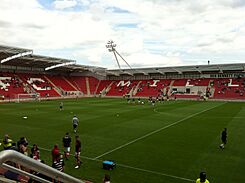
In 2022–23 season, the town's association football team, Rotherham United, played in the EFL Championship, the second tier of English Football. The team currently plays at the New York Stadium. Historically the town was represented by Rotherham Town, and Rotherham County, who both played in the Football League.
Rugby
Rotherham Titans rugby union team reached the Guinness Premiership in 1999 and 2003 before being relegated. The club plays at the Clifton Lane Sports Ground. The town is also represented in rugby league by the Rotherham Giants of the Rugby League Conference.
Cricket
Rotherham Town Cricket Club is an English amateur cricket club with a history dating back to 1846. The club ground is based on Clifton Lane. The club have 2 Saturday senior XI teams that compete in the Yorkshire Cricket Southern Premier League, and a junior training section that play competitive cricket in the Sheffield and District Junior League.
Motor racing
Former Formula One team Virgin Racing were based in Dinnington in the borough. IndyCar and former ChampCar and Formula One driver Justin Wilson was from Woodall, which is in the Metropolitan Borough of Rotherham. Motorcycle speedway racing was staged in the town about 1930.
Greyhound racing
Three greyhound racing tracks existed in or around the town. They were Rotherham Greyhound Stadium (1933-1974); around Millmoor (1930-1933) and in Hellaby. The racing was independent (not affiliated to the sports governing body the National Greyhound Racing Club) and all three tracks were known as flapping tracks, which was the nickname given to independent tracks.
Notable sports persons
Hurdler Chris Rawlinson, Olympic gold medallist sailor Paul Goodison, Olympic silver medallist Peter Elliott, former England goalkeeper David Seaman, golfer Danny Willett and 2010 FIFA World Cup Final referee Howard Webb are all from Rotherham.
Freedom of the borough
On Monday 3 August 2009 Rotherham became the first town to bestow the Freedom of the Borough on the Yorkshire Regiment, giving it the right to march through the town with "flags flying, bands playing and bayonets fixed". At a ceremony outside the Town Hall, the Regiment paraded two Guards of soldiers who had recently returned from Iraq and the Colours of the 3rd Battalion Yorkshire Regiment (Duke of Wellington's), led by the Kings Division Band, under the command of Lieutenant Colonel Vallings, the battalion commanding officer. The Mayor of Rotherham, Councillor Shaukat Ali, on behalf of the borough, presented the Freedom Scroll to Colonel Simon Newton, who accepted the honour for the regiment. The regiment is the only military unit to become Honorary Freemen of the Borough.
Notable people

Rotherham is the hometown of the Chuckle Brothers, Manchester City and England forward Jess Park, Huddersfield Town and Arsenal manager, Herbert Chapman (born in Kiveton Park, which was amalgamated into Rotherham in 1974), Arsenal and England goalkeeper David Seaman, along with World Cup and English Premier League referee Howard Webb. Sean Bean began his acting career in Rotherham while actors Liz White, Ryan Sampson, Dean Andrews and Darrell D'Silva also hail from Rotherham, as does former leader of the Conservative Party, William Hague, and Sir Donald Coleman Bailey. Presenter James May grew up in Rotherham. His co-presenter on Top Gear Jeremy Clarkson trained to be a journalist at the Rotherham Advertiser.
Comedians Sandy Powell and Duggie Brown were born in Rotherham, as was actress Lynne Perrie. Christopher Wolstenholme of Muse, DJ Kritikal Mass, Dean Andrews of Life on Mars, artist Margaret Clarkson, band Jive Bunny & The Mastermixers, musician Rebecca Taylor and singer-actor Rob McVeigh were all born or mostly raised in Rotherham.
Twin towns
Rotherham's official twin towns are:
- Saint-Quentin, Aisne, France
Partner towns
Rotherham has three partner towns:
- Cluj-Napoca, Romania
- Riesa, Germany
- Zabrze, Poland
See also
 In Spanish: Rotherham para niños
In Spanish: Rotherham para niños









